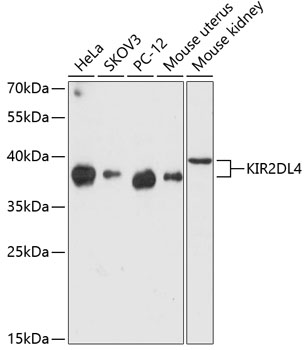| Background: | Killer cell immunoglobulin-like receptors (KIRs) are transmembrane glycoproteins expressed by natural killer cells and subsets of T cells. The KIR genes are polymorphic and highly homologous and they are found in a cluster on chromosome 19q13.4 within the 1 Mb leukocyte receptor complex (LRC). The gene content of the KIR gene cluster varies among haplotypes, although several 'framework' genes are found in all haplotypes (KIR3DL3, KIR3DP1, KIR3DL4, KIR3DL2). The KIR proteins are classified by the number of extracellular immunoglobulin domains (2D or 3D) and by whether they have a long (L) or short (S) cytoplasmic domain. KIR proteins with the long cytoplasmic domain transduce inhibitory signals upon ligand binding via an immune tyrosine-based inhibitory motif (ITIM), while KIR proteins with the short cytoplasmic domain lack the ITIM motif and instead associate with the TYRO protein tyrosine kinase binding protein to transduce activating signals. The ligands for several KIR proteins are subsets of HLA class I molecules; thus, KIR proteins are thought to play an important role in regulation of the immune response. This gene is one of the 'framework' loci that is present on all haplotypes. Alternate alleles of this gene are represented on multiple alternate reference loci (ALT_REF_LOCs). Alternative splicing results in multiple transcript variants, some of which may not be annotated on the primary reference assembly. |
| UniProt Protein Function: | Receptor on natural killer (NK) cells for HLA-C alleles. Inhibits the activity of NK cells thus preventing cell lysis. |
| NCBI Summary: | Killer cell immunoglobulin-like receptors (KIRs) are transmembrane glycoproteins expressed by natural killer cells and subsets of T cells. The KIR genes are polymorphic and highly homologous and they are found in a cluster on chromosome 19q13.4 within the 1 Mb leukocyte receptor complex (LRC). The gene content of the KIR gene cluster varies among haplotypes, although several "framework" genes are found in all haplotypes (KIR3DL3, KIR3DP1, KIR3DL4, KIR3DL2). The KIR proteins are classified by the number of extracellular immunoglobulin domains (2D or 3D) and by whether they have a long (L) or short (S) cytoplasmic domain. KIR proteins with the long cytoplasmic domain transduce inhibitory signals upon ligand binding via an immune tyrosine-based inhibitory motif (ITIM), while KIR proteins with the short cytoplasmic domain lack the ITIM motif and instead associate with the TYRO protein tyrosine kinase binding protein to transduce activating signals. The ligands for several KIR proteins are subsets of HLA class I molecules; thus, KIR proteins are thought to play an important role in regulation of the immune response. This gene is one of the "framework" loci that is present on all haplotypes. Alternate alleles of this gene are represented on multiple alternate reference loci (ALT_REF_LOCs). Alternative splicing results in multiple transcript variants, some of which may not be annotated on the primary reference assembly. [provided by RefSeq, Jul 2016] |
| UniProt Code: | Q99706 |
| NCBI GenInfo Identifier: | 325511396 |
| NCBI Gene ID: | 3805 |
| NCBI Accession: | Q99706.3 |
| UniProt Secondary Accession: | Q99706,O14621, O14622, O14623, O14624, O43534, P78400 P78401, Q8N738, Q99559, Q99560, A8W795, |
| UniProt Related Accession: | Q99706 |
| Molecular Weight: | 24,917 Da |
| NCBI Full Name: | Killer cell immunoglobulin-like receptor 2DL4 |
| NCBI Synonym Full Names: | killer cell immunoglobulin like receptor, two Ig domains and long cytoplasmic tail 4 |
| NCBI Official Symbol: | KIR2DL4 |
| NCBI Official Synonym Symbols: | G9P; CD158D; KIR103; KIR-2DL4; KIR103AS; KIR-103AS |
| NCBI Protein Information: | killer cell immunoglobulin-like receptor 2DL4 |
| UniProt Protein Name: | Killer cell immunoglobulin-like receptor 2DL4 |
| UniProt Synonym Protein Names: | CD158 antigen-like family member D; G9P; Killer cell inhibitory receptor 103AS; KIR-103AS; MHC class I NK cell receptor KIR103AS; CD_antigen: CD158d |
| Protein Family: | Killer cell immunoglobulin-like receptor |
| UniProt Gene Name: | KIR2DL4 |







